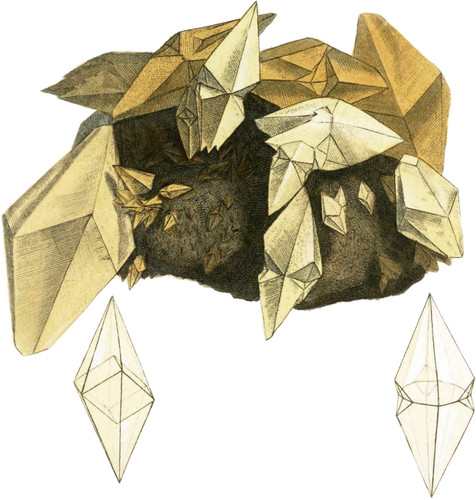 Enlarge
Enlarge
British Mineralogy
Carbonate of Lime, var. metastatic
- Class 2. Earths.
- Order 1. Homogeneous.
- Gen. 1. Lime.
- Spec. Carbonate of Lime.
- Div. 1. Crystalized.
- Var. Metastatic.
- Syn.
- Dent de cochon. De Lisle, tab. 1. p. 530.
- Chaux carbonatée metastatique. D2r Hauy, v. 2. p. 134.
This form or variety of crystallization of carbonate of lime is perhaps one of the most common, and has obtained the name of Dog’s tooth spar in England, and that of Dent de cochon, or Swine’s tooth, in France. This crystallization is prevalent of different sizes, colours, &c., in Derbyshire, some affording good examples of the primitive rhomb, being clear, and differing very little from the true Iceland crystal, which is reckoned the most pellucid, and for a figure of which see our tab. 2. The left hand lower figure shows the usual construction, the edges of the opposite pyramids meeting on the edges of the primitive rhomb, when the obtuse ends are opposite to each apex*, the more acute angles forming three principal ones, and the obtuse three less distinct ones: thus each pyramid has six sides, the acute and obtuse meeting in alternate order at the common base. The right hand figure represents two pyramids of the same, transversely cut through the middle, showing a plane of 12 sides, and turned on the axis till they meet each other in an opposite direction, exhibiting a remarkable appearance, called by some authors macling. They often seem to be two crystals passing into each other, and are then said to be twins. This is formed on a gangue or lump of manganese, or black was as the miners term it, which seems to give the crystals a dirty tinge, especially those nearest to it. We do not know that it has any other effect on the crystallization.

